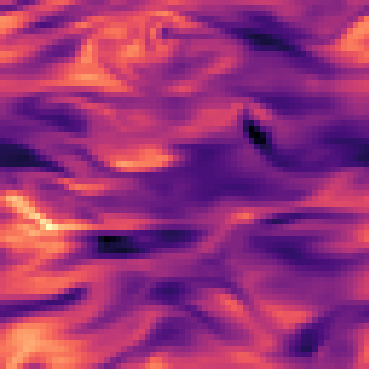Datasets:
language:
- en
license: cc-by-4.0
tags:
- physics
task_categories:
- time-series-forecasting
- other
task_ids:
- multivariate-time-series-forecasting
How To Load from HuggingFace Hub
- Be sure to have
the_wellinstalled (pip install the_well) - Use the
WellDataModuleto retrieve data as follows:
from the_well.benchmark.data import WellDataModule
# The following line may take a couple of minutes to instantiate the datamodule
datamodule = WellDataModule(
"hf://datasets/polymathic-ai/",
"MHD_64",
)
train_dataloader = datamodule.train_dataloader()
for batch in dataloader:
# Process training batch
...
Magnetohydrodynamics (MHD) compressible turbulence
NOTE: This dataset is available in two different resolutions for MHD_256 and for MHD_64. The data was first generated at and then downsampled to after anti-aliasing with an ideal low-pass filter. The data is available in both resolutions.
One line description of the data: This is an MHD fluid flows in the compressible limit (subsonic, supersonic, sub-Alfvenic, super-Alfvenic).
Longer description of the data: An essential component of the solar wind, galaxy formation, and of interstellar medium (ISM) dynamics is magnetohydrodynamic (MHD) turbulence. This dataset consists of isothermal MHD simulations without self-gravity (such as found in the diffuse ISM) initially generated with resolution and then downsampled to after anti-aliasing with an ideal low-pass filter. This dataset is the downsampled version.
Associated paper: Paper
Domain expert: Blakesley Burkhart, CCA, Flatiron Institute & Rutgers University.
Code or software used to generate the data: Fortran + MPI.
Equation:
\begin{align}
\frac{\partial \rho}{\partial t} + \nabla \cdot (\rho \mathbf{v}) &= 0 \nonumber\\
\frac{\partial \rho \mathbf{v}}{\partial t} + \nabla \cdot (\rho \mathbf{v} \mathbf{v} - \mathbf{B} \mathbf{B}) + \nabla p &= 0 \nonumber\\
\frac{\partial \mathbf{B}}{\partial t} - \nabla \times (\mathbf{v} \times \mathbf{B}) &= 0 \nonumber\\
\end{align}
where is the density, is the velocity, is the magnetic field, the identity matrix and is the gas pressure.
| Dataset | FNO | TFNO | Unet | CNextU-net |
|---|---|---|---|---|
MHD_64 |
0.3605 | 3561 | 0.1798 | \(\mathbf{0.1633}\) |
Table: VRMSE metrics on test sets (lower is better). Best results are shown in bold. VRMSE is scaled such that predicting the mean value of the target field results in a score of 1.
About the data
Dimension of discretized data: 100 timesteps of 64 64 64 cubes.
Fields available in the data: Density (scalar field), velocity (vector field), magnetic field (vector field).
Number of trajectories: 10 Initial conditions x 10 combination of parameters = 100 trajectories.
Estimated size of the ensemble of all simulations: 71.6 GB.
Grid type: uniform grid, cartesian coordinates.
Initial conditions: uniform IC.
Boundary conditions: periodic boundary conditions.
Data are stored separated by (\(\Delta t\)): 0.01 (arbitrary units).
Total time range (\(t_{min}\) to ): , .
Spatial domain size (\(L_x\), , ): dimensionless so 64 pixels.
Set of coefficients or non-dimensional parameters evaluated: all combinations of {0.5, 0.7, 1.5, 2.0 7.0} and {0.7, 2.0}.
Approximate time and hardware used to generate the data: Downsampled from MHD_256 after applying ideal low-pass filter.
What is interesting and challenging about the data:
What phenomena of physical interest are catpured in the data: MHD fluid flows in the compressible limit (sub and super sonic, sub and super Alfvenic).
How to evaluate a new simulator operating in this space: Check metrics such as Power spectrum, two-points correlation function.
Please cite the associated paper if you use this data in your research:
@article{burkhart2020catalogue,
title={The catalogue for astrophysical turbulence simulations (cats)},
author={Burkhart, B and Appel, SM and Bialy, S and Cho, J and Christensen, AJ and Collins, D and Federrath, Christoph and Fielding, DB and Finkbeiner, D and Hill, AS and others},
journal={The Astrophysical Journal},
volume={905},
number={1},
pages={14},
year={2020},
publisher={IOP Publishing}
}
